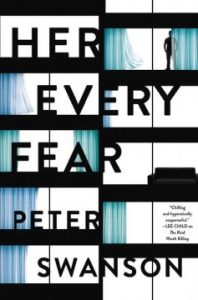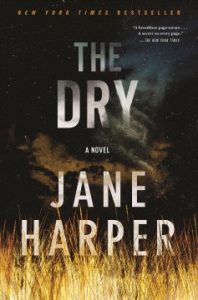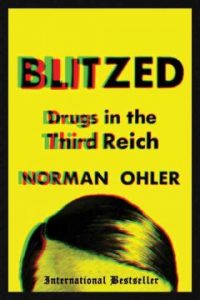Remember when everyone was thinking of heading to the beach in February, dear readers? Well, as we all knew, here we are in March paying for the unseasonable warmth with…unseasonable cold. March, it truly seems, has trotted in like the proverbial lion…

…But is that what that phrase actually means? A few years ago, The Paris Review published a fascinating piece on the phrase “in like a lion, out like a lamb”, trying to conclude the origin of the phrase in an article that is both informative and delightfully quirky. I’ll just leave it here for you to check out.
And if you’re looking for things to keep you busy this chilly weekend, here are a selection of the super-terrific books that have waltzed their way onto our shelves this week, and are very eager to make your acquaintance! Though the summer thrillers are already making their appearance, they are also perfectly suitable for helping you through a lion-like March just fine:

 The Girl Before: Oh hey, look! It’s another book with “Girl” in the title. *Sigh*. Anyways, despite my overwhelming frustration with this trend, there’s no arguing that J.P. Delaney’s is getting everyone very excited–critics, authors, and reviewers alike are raving, and Ron Howard has already started adapting it for film. The story centers around two women who, it would seem, have found the perfect home; an architectural marvel; a masterpiece in design. However, enigmatic architect who designed the house retains full control: no books, no throw pillows, no photos or clutter or personal effects of any kind. The space is intended to transform its occupant—and it does.. But before they move in, they are both confronted with an odd request….Please make a list of every possession you consider essential to your life. For Emma, who is still coping with the after-effects of a traumatic break-in, this is the first place that feels safe. For Jane, who is dealing with a painful tragedy, the place (and its creator) are a haven and a welcome distraction. Until Jane learns about the girl before her, and her untimely end. And as she tries to uncover the truth about Emma, she finds herself caught in the same situation, encountering the same people–and sharing the same fate? This is a twisty, turny, psychological novel that is drawing comparisons to Gillian Flynn and Paula Hawkins, with the USA Today gleefully commenting that “Delaney has created a genuinely eerie, fascinating setting in One Folgate Street. . . . The novel’s structure, volleying back and forth as first Emma and then Jane begin to question their improbable luck, is beautifully handled. The pages fly.”
The Girl Before: Oh hey, look! It’s another book with “Girl” in the title. *Sigh*. Anyways, despite my overwhelming frustration with this trend, there’s no arguing that J.P. Delaney’s is getting everyone very excited–critics, authors, and reviewers alike are raving, and Ron Howard has already started adapting it for film. The story centers around two women who, it would seem, have found the perfect home; an architectural marvel; a masterpiece in design. However, enigmatic architect who designed the house retains full control: no books, no throw pillows, no photos or clutter or personal effects of any kind. The space is intended to transform its occupant—and it does.. But before they move in, they are both confronted with an odd request….Please make a list of every possession you consider essential to your life. For Emma, who is still coping with the after-effects of a traumatic break-in, this is the first place that feels safe. For Jane, who is dealing with a painful tragedy, the place (and its creator) are a haven and a welcome distraction. Until Jane learns about the girl before her, and her untimely end. And as she tries to uncover the truth about Emma, she finds herself caught in the same situation, encountering the same people–and sharing the same fate? This is a twisty, turny, psychological novel that is drawing comparisons to Gillian Flynn and Paula Hawkins, with the USA Today gleefully commenting that “Delaney has created a genuinely eerie, fascinating setting in One Folgate Street. . . . The novel’s structure, volleying back and forth as first Emma and then Jane begin to question their improbable luck, is beautifully handled. The pages fly.”
 Her Every Fear: And while we’re on the topic of houses being scary, Peter Swanson’s newest book features a Boston house doing it’s best to freak us all out, and the woman who has to face down the truth these walls conceal. Kate Priddy has always been anxious and perhaps a bit obsessive–traits that grow nearly crippling after an ex-boyfriend kidnaps and nearly kills her. When Corbin Dell, a distant cousin in Boston, suggests the two temporarily swap apartments, Kate, now an art student in London, leaps at the idea, hoping that a change of scene will help her get a grip on her life again. But soon after her arrival at Corbin’s Beacon Hill apartment, Kate makes a shocking discovery: his next-door neighbor, a young woman named Audrey Marshall, has been murdered. Though Corbin is quick to profess his innocence, several discoveries in the apartment make the jet-lagged Kate more and more uneasy about her cousin–and Alan, the quiet, attractive young man across the courtyard. Is there anyone she can trust? Swanson excels at writing good noir, shifting narrative perspective with ease and creating an atmosphere that is being compared to Hitchcock’s Rear Window as his heroine confronts the evil before her and the fear inside her in a story that earned a starred review from Booklist, who said “The skillfully conjured Boston winter creates the perfect atmosphere for breeding paranoia… Swanson … introduces a delicious monster-under-the-bed creepiness to the expected top-notch characterization and steadily mounting anxiety.”
Her Every Fear: And while we’re on the topic of houses being scary, Peter Swanson’s newest book features a Boston house doing it’s best to freak us all out, and the woman who has to face down the truth these walls conceal. Kate Priddy has always been anxious and perhaps a bit obsessive–traits that grow nearly crippling after an ex-boyfriend kidnaps and nearly kills her. When Corbin Dell, a distant cousin in Boston, suggests the two temporarily swap apartments, Kate, now an art student in London, leaps at the idea, hoping that a change of scene will help her get a grip on her life again. But soon after her arrival at Corbin’s Beacon Hill apartment, Kate makes a shocking discovery: his next-door neighbor, a young woman named Audrey Marshall, has been murdered. Though Corbin is quick to profess his innocence, several discoveries in the apartment make the jet-lagged Kate more and more uneasy about her cousin–and Alan, the quiet, attractive young man across the courtyard. Is there anyone she can trust? Swanson excels at writing good noir, shifting narrative perspective with ease and creating an atmosphere that is being compared to Hitchcock’s Rear Window as his heroine confronts the evil before her and the fear inside her in a story that earned a starred review from Booklist, who said “The skillfully conjured Boston winter creates the perfect atmosphere for breeding paranoia… Swanson … introduces a delicious monster-under-the-bed creepiness to the expected top-notch characterization and steadily mounting anxiety.”
 The Dry: From the chill of a Boston winter, we move to the deadly heat of an Australian summer in Jane Harper’s mystery debut. Federal Agent Aaron Falk arrives in his hometown for the first time in decades, after being summoned to attend the funeral of his best friend, Luke. Two decades ago, Falk was accused of murder, and Luke was his alibi. Falk and his father fled under a cloud of suspicion, saved from prosecution only because of Luke’s steadfast claim that the boys had been together at the time of the crime. But now more than one person knows they didn’t tell the truth back then, and Luke is dead. Now, amidst the worst drought in a century, Aaron is beginning to realize just how well little towns can keep secrets–and to discover who killed his best friend. In addition to praising Harper’s ability to set a scene, crafting the choking heat and creeping menace of a hometown that will make your skin crawl, her talent at crafting a mystery has reviewers raving. Kirkus gave it a starred review, declaring it “A nail-biting thriller…A chilling story set under a blistering sun, this fine debut will keep readers on edge and awake long past bedtime.”
The Dry: From the chill of a Boston winter, we move to the deadly heat of an Australian summer in Jane Harper’s mystery debut. Federal Agent Aaron Falk arrives in his hometown for the first time in decades, after being summoned to attend the funeral of his best friend, Luke. Two decades ago, Falk was accused of murder, and Luke was his alibi. Falk and his father fled under a cloud of suspicion, saved from prosecution only because of Luke’s steadfast claim that the boys had been together at the time of the crime. But now more than one person knows they didn’t tell the truth back then, and Luke is dead. Now, amidst the worst drought in a century, Aaron is beginning to realize just how well little towns can keep secrets–and to discover who killed his best friend. In addition to praising Harper’s ability to set a scene, crafting the choking heat and creeping menace of a hometown that will make your skin crawl, her talent at crafting a mystery has reviewers raving. Kirkus gave it a starred review, declaring it “A nail-biting thriller…A chilling story set under a blistering sun, this fine debut will keep readers on edge and awake long past bedtime.”
 The Aleppo Cookbook: It probably should come as a surprise that one of the world’s most long-inhabited cities is also home to some of its richest culinary traditions. And in this stunning new cookbook, Marlene Matar, one of the Arab world’s most renown chefs, takes us on a tour of the many cultures, people, and ingredients that have shaped, and been shaped by, this remarkable city. Along with the requisite pictures of food (which are quite enough to produce a fit of the munchies in and of themselves), there are also a number of photographs of the markets and people of Aleppo, offering readers insight into life there today. The result is a deliciously enticing cookbook, as well as a haunting testament to the survival, endurance, and humanity of the people of Syria.
The Aleppo Cookbook: It probably should come as a surprise that one of the world’s most long-inhabited cities is also home to some of its richest culinary traditions. And in this stunning new cookbook, Marlene Matar, one of the Arab world’s most renown chefs, takes us on a tour of the many cultures, people, and ingredients that have shaped, and been shaped by, this remarkable city. Along with the requisite pictures of food (which are quite enough to produce a fit of the munchies in and of themselves), there are also a number of photographs of the markets and people of Aleppo, offering readers insight into life there today. The result is a deliciously enticing cookbook, as well as a haunting testament to the survival, endurance, and humanity of the people of Syria.
 Blitzed: Drugs in the Third Reich: It has taken several generations of historians to being to tackle the nuances and intricacies of the Third Reich–and understandably so, as we are still trying to cope with the larger horrors of the Holocaust–but within recent years, some genuinely fascinating pieces have been written on gender, economics, humor and, now, on the drugs of Hitler’s Germany. Though the Nazi party may have touted an ideology of physical, mental, and moral purity, Norman Ohler reveals that the Third Reich was actually saturated with drugs of all kinds. Powerhouses like Merck and Bayer cooked up cocaine, opiates, and, most of all, methamphetamines, to be consumed by everyone from factory workers to housewives to millions of German soldiers. Indeed, soldiers were fed a form of crystal meth in order to keep their morale and ‘fighting spirit’ high (which is a big step up from the cocaine that they were fed during the First World War). Rather than seeing this widespread intoxication as an excuse or a rationale for the course of history, Ohler instead argues that drugs are a vital way of making sense of Nazi German society. His work is well-researched and completely readable, making for a book that has been garnering praise from historians and pop-culture outlets alike, with the British Times praising its depiction of “how Nazi Germany slid towards junkie-state status. It is an energetic … account of an accelerating, modernizing society, an ambitious pharmaceuticals industry, a military machine that was looking for ways to create an unbeatable soldier, and a dictator who couldn’t function without fixes from his quack … It has an uncanny ability to disturb.”
Blitzed: Drugs in the Third Reich: It has taken several generations of historians to being to tackle the nuances and intricacies of the Third Reich–and understandably so, as we are still trying to cope with the larger horrors of the Holocaust–but within recent years, some genuinely fascinating pieces have been written on gender, economics, humor and, now, on the drugs of Hitler’s Germany. Though the Nazi party may have touted an ideology of physical, mental, and moral purity, Norman Ohler reveals that the Third Reich was actually saturated with drugs of all kinds. Powerhouses like Merck and Bayer cooked up cocaine, opiates, and, most of all, methamphetamines, to be consumed by everyone from factory workers to housewives to millions of German soldiers. Indeed, soldiers were fed a form of crystal meth in order to keep their morale and ‘fighting spirit’ high (which is a big step up from the cocaine that they were fed during the First World War). Rather than seeing this widespread intoxication as an excuse or a rationale for the course of history, Ohler instead argues that drugs are a vital way of making sense of Nazi German society. His work is well-researched and completely readable, making for a book that has been garnering praise from historians and pop-culture outlets alike, with the British Times praising its depiction of “how Nazi Germany slid towards junkie-state status. It is an energetic … account of an accelerating, modernizing society, an ambitious pharmaceuticals industry, a military machine that was looking for ways to create an unbeatable soldier, and a dictator who couldn’t function without fixes from his quack … It has an uncanny ability to disturb.”
Until next week, beloved patrons–happy reading!
